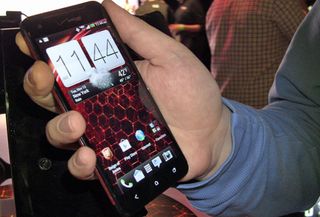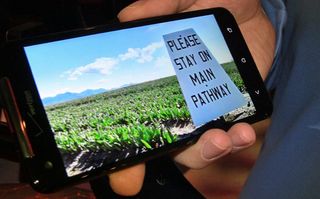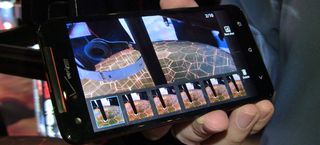HTC Droid DNA Tested: Amazing HD Screen, Quick Camera, Same Sense UI

With a 1920 x 1080, 5-inch screen, a speedy Qualcomm Snapdragon Processor and HTC's imaging technology, the HTC Droid DNA has a lot going for it, including its price. At $199, this phone is significantly less expensive than the $299 Galaxy Note II and on par with other competitors like the Motorola Droid RAZR HD and Galaxy S III. We have a unit in our office now and have begun testing it for a full review which we expect to publish within the next day or two. However, in the meantime, we've developed some strong first impressions.
A Full HD Screen
There's no doubt that at 1920 x 1080, an industry-leading 440 pixels-per-inch, the HTC Droid DNA has the sharpest screen on the market. When we put the DNA's screen next to the Galaxy Note II's 5.5-inch 1280 x 720 display, a high-res image of a tiger was not only sharper, but brighter than than on the Samsung display.
The Super LCD 3 screen on the DNA provides images that are more detailed and true-to-life than those on the AMOLED-based Galaxy Note II. Watching a YouTube trailer for Skyfall on both screens, colors were much more accurate on the HTC DNA, but had more contrast and popped more on the Note II. In a scene where Daniel Craig is coming out of a swimming pool, the water reflected a fairly realistic blue shadow on his skin when viewed on the HTC screen while he looked as blue as a Naavi on the Samsung display.

Measuring in at 311 lux on our light meter, the HTC DNA's scren is significantly brighter than the 211 lux Galaxy Note II and 213 lux Galaxy S III. However, the iPhone 5 and HTC One X both outshined the DNA with 525 lux displays.
Android 4.1 OS and UI
The Droid DNA runs Android 4.1 Jellybean, but you'd be forgiven if you couldn't tell just from looking at the screen. As with its other Android devices, HTC has paved over Android with its heavy Sense UI, which is now in version 4.0 plus. That means all of the icons, widgets and fonts have HTC's distinct aesthetic which some love and some hate.
Stay in the know with Laptop Mag
Get our in-depth reviews, helpful tips, great deals, and the biggest news stories delivered to your inbox.
Unlike stock Android, Sense UI provides hardware navigation buttons for back, home and task switching rather than wasting screen real estate. However, we're less fond of HTC's task-switching menu which takes over the whole screen and displays your apps as 3D cards, rather than neatly stacking them up as thumbnails as it would in stock Android 4.1. The Droid DNA has Google Now enabled, but you need to press and hold the home button to activate it as opposed to swiping up from the bottom like you would on stock Android.
The keyboard is HTC's keyboard, not Google's, which means the keys are a dull gray rather than the vibrant blue we see on Motorola's stock Android implementation. Like Samsung's keyboard on the Galaxy Note II, it supports a trace mode. The phone supports haptic feedback, but unfortunately the buzz was a little light for our tastes.
Performance
With its 1.5-GHz quad-core, Snapdragon S4 CPU, the HTC Droid DNA delivers plenty of performance. We haven't had the chance to run it through of all our tests yet, but on everything we've thrown at it, the results have been nothing short of impressive. On Quadrant, a benchmark that measures overall system speed, the Droid DNA scored a blistering 7,011, significantly faster than the Galaxy Note II's 6,275 score and more than double the 3,219 smartphone category average.
Camera
HTC boasts an 8-MP rear camera with a strong f/2.0 aperture, with the same high-speed ImageSense chip found in the HTC One series of phones. In our tests, the handset was very quick to the first shot (under 1 second), provided that it did not need to refocus or use the flash. However, when it did have to refocus, shots could take between 1 and 2 seconds while they were closer to 2 seconds when the DNA had to use the flash.
As on the HTC One series, the Droid DNA supports burst mode, which will take up to 99 pictures in a row with just .2 second intervals between them. Then you can comb through the shots and select a "best shot" to keep while the others get thrown away.

Indoor photos taken of some holiday decorations and a Grover action figure were sharp and detailed, but not overly rich. Despite its f/2.0 lens, the camera still resorted to autoflash even in reasonably well-lit rooms of our office, until we manually disabled it.

Early Outlook
The HTC DNA breaks new ground with its screen and, when you combine that with its speedy camera and quad-core CPU, makes it a steal at $199. However, whether this phone is right for you will come down to a few key questions.
First, how's the battery life? With a mere 2,020 mAH non-removable battery under the hood we're hopeful this phone will get at least 6 hours on our benchmark test. Meanwhile, the Galaxy Note II has over 9 hours of endurance and the Droid RAZR Maxx HD lasted 8:13. Think battery life doesn't matter? Just wait until the next blackout.
Second, do you like HTC's Sense UI? If you like or are in different to it, the DNA could be a great phone for you. However, if you want a purer Android experience, you should look at the Droid RAZR HD Maxx or the Nexus 4. If you want a more innovative software ovelay, Samsung's Touchwiz allows for multitasking by showing multiple apps at once on the Galaxy Note II.
Finally, you'll need to ask if you're looking for a smarphone or a phablet. With its light 4.8-ounce chassis, the HTC Droid DNA is clearly a large smartphone, not a small tablet. If you want a large phone for scralling notes, the Note II fits the bill. Stay tuned for our full review of the HTC Droid DNA.
